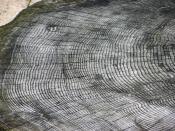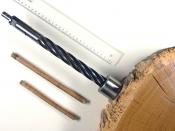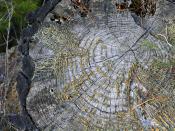Dendrochronology is the dating of the past through the study of tree ring growth. Dendrochronology is based on the principle that most trees produce new growth rings each year, in between their wood and the bark. The thickness of each of the tress rings varies depending on the environmental conditions from year to year. A thick ring will indicate lots of growth, telling you that it was a very wet year. Where as, thin ring indicates a very minimal amount of growth, informing us that it was a dry year.
If the size of a tree's rings varies depending on environmental factors then we can conclude that trees in a similar region will have similar rings. This allows us to cross-date rings. Matching patterns in ring widths among several different trees allow the identification of the exact year in which each tree ring was formed. For example, one can date the year in which a building was formed, (such as a barn), by matching the tree-ring patterns of wood taken from the buildings with tree-ring patterns from living trees.
This allows for very accurate dating of wood samples. Archaeological samples of wood for tree ring dating can be extracted in a small-diameter core sample using a boring tool. Then the width of the growth rings are measured, and compared to others.
In order for this to be a reliable method for dating,
four factors must be present:
1. The species studied must only produce one ring per growing season or year.
2. Only one dominant environmental factor can be the cause of hindered or increased growth.
3. The dominant environmental factor should vary each year so we can see the changes clearly in every ring.
4. And lastly, the environmental factor must affect a large geographic area so testing can...


